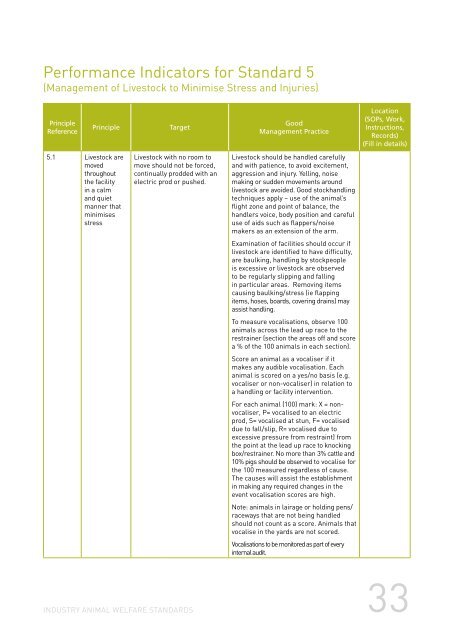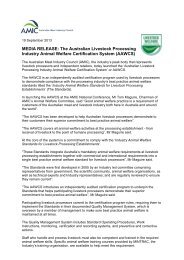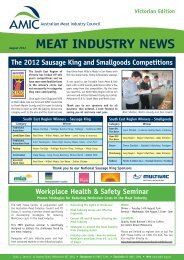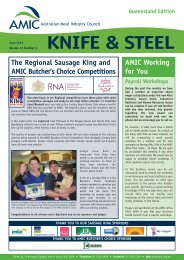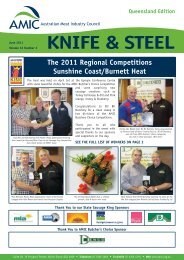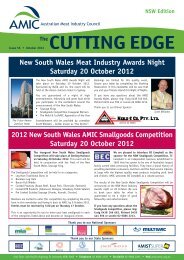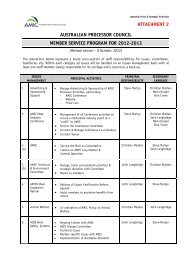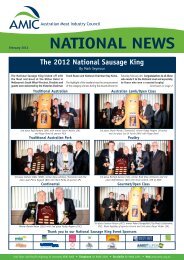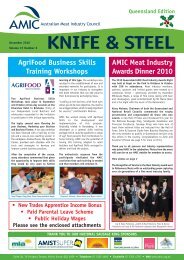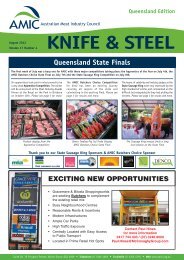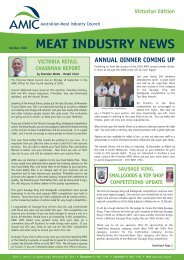Animal Welfare Standards - Australian Meat Industry Council
Animal Welfare Standards - Australian Meat Industry Council
Animal Welfare Standards - Australian Meat Industry Council
Create successful ePaper yourself
Turn your PDF publications into a flip-book with our unique Google optimized e-Paper software.
Performance Indicators for Standard 5<br />
(Management of Livestock to Minimise Stress and Injuries)<br />
Principle<br />
Reference<br />
5.1 Livestock are<br />
moved<br />
throughout<br />
the facility<br />
in a calm<br />
and quiet<br />
manner that<br />
minimises<br />
stress<br />
Principle Target<br />
Livestock with no room to<br />
move should not be forced,<br />
continually prodded with an<br />
electric prod or pushed.<br />
INDUSTRY ANIMAL WELFARE STANDARDS<br />
Good<br />
Management Practice<br />
Livestock should be handled carefully<br />
and with patience, to avoid excitement,<br />
aggression and injury. Yelling, noise<br />
making or sudden movements around<br />
livestock are avoided. Good stockhandling<br />
techniques apply – use of the animal’s<br />
flight zone and point of balance, the<br />
handlers voice, body position and careful<br />
use of aids such as flappers/noise<br />
makers as an extension of the arm.<br />
Examination of facilities should occur if<br />
livestock are identified to have difficulty,<br />
are baulking, handling by stockpeople<br />
is excessive or livestock are observed<br />
to be regularly slipping and falling<br />
in particular areas. Removing items<br />
causing baulking/stress (ie flapping<br />
items, hoses, boards, covering drains) may<br />
assist handling.<br />
To measure vocalisations, observe 100<br />
animals across the lead up race to the<br />
restrainer (section the areas off and score<br />
a % of the 100 animals in each section).<br />
Score an animal as a vocaliser if it<br />
makes any audible vocalisation. Each<br />
animal is scored on a yes/no basis (e.g.<br />
vocaliser or non-vocaliser) in relation to<br />
a handling or facility intervention.<br />
For each animal (100) mark: X = nonvocaliser,<br />
P= vocalised to an electric<br />
prod, S= vocalised at stun, F= vocalised<br />
due to fall/slip, R= vocalised due to<br />
excessive pressure from restraint) from<br />
the point at the lead up race to knocking<br />
box/restrainer. No more than 3% cattle and<br />
10% pigs should be observed to vocalise for<br />
the 100 measured regardless of cause.<br />
The causes will assist the establishment<br />
in making any required changes in the<br />
event vocalisation scores are high.<br />
Note: animals in lairage or holding pens/<br />
raceways that are not being handled<br />
should not count as a score. <strong>Animal</strong>s that<br />
vocalise in the yards are not scored.<br />
Vocalisations to be monitored as part of every<br />
internal audit.<br />
Location<br />
(SOPs, Work,<br />
Instructions,<br />
Records)<br />
(Fill in details)<br />
33


